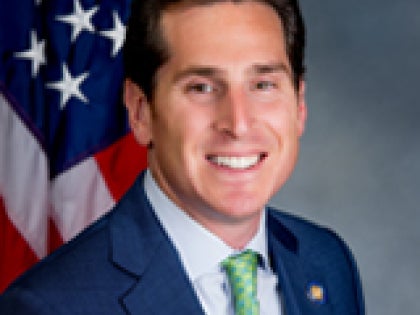
PSEG agrees to reimburse residential customers up to $250 for spoiled food
PSEG Long Island on Monday said it would reimburse customers who experienced an outage of 72 hours or more for some food and medicine losses in the aftermath of Tropical Storm Isaias.
The new policy will reimburse residential customers for spoiled food up to $250 in losses, while commercial customers such as restaurants can receive up to $5,000 in reimbursements, PSEG said. It’s unclear how PSEG intends to pay for the reimbursement, or how much it’s expected to cost.
The announcement came on the same day PSEG Long Island president and chief operating officer Dan Eichhorn called the company’s “frustrating” performance in response to Isaias “an anomaly,” and pinned a giant part of the problem on a computer system that was supposed to tally and manage outages.
Eichhorn spoke during a hearing of the Nassau Legislature about the utility company's response to the Aug. 4 storm that caused extensive damage across Long Island, leaving about 420,000 customers without power.
For those looking for reimbursements, residential food losses of $150 and under must include an itemized list of the food lost, while food losses over $150 require an itemized list and “proof of loss,” including register receipt, canceled check or photos of spoiled items, PSEG said.
Medicine lost will be reimbursed up to $300, PSEG said. Customers will have to provide an itemized list and proof of loss, including pharmacy prescription label or receipt.
For commercial customers, PSEG requires an itemized list of spoiled food and proof, including invoices or bank statements.
Customers can file for reimbursement at www.psegliny.com/claims and must file claims by Sept 16. It could take up to 60 days for reimbursement.
State Sen. Todd Kaminsky (D-Long Beach), who was among local leaders to call for the reimbursement policy, along with Nassau County Executive Laura Curran, said the policy was “the least they can do.”
“While the policy should be inclusive of more customers and more generous, this was a just result and a rare victory for the average taxpayer against a powerful utility — but our efforts must not stop there,” he said in a statement. The Senate will hold a hearing on PSEG on Aug 20.
PSEG and LIPA as a general policy don’t reimburse customers for weather-related losses, according to terms in the LIPA rule book, but neighboring utility Con Ed announced earlier this month that it would, for upward of $540 for residential customer losses.
“Given the unique combination of circumstances, we believe the right thing to do is to expand our claims process to ease the burden on the customers most impacted by Tropical Storm Isaias,” Eichhorn said in a statement.
PSEG has taken on withering criticism to its response to the storm, including customers’ inability to get through on telephone, online, text and mobile app communications lines, and the failure of the company’s ability to estimate customer restoration times.
Eichhorn said during the Nassau hearing that the company and its employees were equally frustrated by those problems and PSEG was doing a “deep dive” to find the root causes of the problem and deal with them.
One of the big problems, he told legislators, was PSEG’s outage-management computer system. PSEG advocated for and installed the $30.6 million system in 2014 — the year it took over management of the grid. PSEG, rather than LIPA, owns the system, a fact that made it ineligible for a $50 million reimbursement grant, Newsday reported. The company at the time said the system allowed the utility to “more quickly and accurately” identify outage locations and provide “better estimated restoration times,” Newsday reported in 2014. Eichhorn acknowledged it did not work.
“We clearly know that one of the key contributors was the failure of our outage management system to perform as designed at the beginning of the storm,” Eichhorn told legislators in opening remarks.
Eichhorn said the failure of that system led the company to resort to “manual processes” to filter through new work generated through the system that had not been identified the prior day. It also required the company to weed out “duplicative” work.
“A significant effort was required each morning to separate and rationalize the legitimate new work from the duplicate work, followed by modifications to the storm work plan,” he said. “These changes to the storm work plan resulted in frequent changes to certain customer restoration times.”
Customers in the days after the storm told of almost daily changes in the restoration times reported by PSEG, if they could get them. Some customers waited for restoration “appointments” as if they were dental appointments, only to be disappointed.
Legislators at the meeting expressed particular concern that the storm, while bearing strong winds, could have been much worse.
“This was not the big storm we were afraid of getting and the reaction to it was much more difficult than we would expect,” said Legis. Delia DeRiggi-Whitton (D-Glen Cove). “We could have it in the next couple of weeks … there could be much worse coming, and we just feel the reaction to this was extremely poor … It’s not only that we expected more, but we’ve been told to expect more. This was not a hurricane.”
Long Island experienced wind gusts of up to 78 mph. It took PSEG almost two weeks to restore power to all customers.
Eichhorn said the company knows that bad weather is the new norm.
“We realize that extreme weather as evidenced by Tropical Storm Isaias is becoming more prevalent and more unpredictable,” he said. “We also fully appreciate that customers expect better communications and overall responsiveness … We are working diligently to be prepared for the next major weather event, and ensure that PSEG Long Island’s response to this storm was an anomaly.”
Eichhorn also noted the damage was considerably greater than expected, with more damage experienced at locations than the utility has had in past storms. That increased work and threw off the company’s internal models for restoration times, he added. “Our past models really did not work,” he said. Those will be updated.
LIPA is expected to apply to the Federal Emergency Management Agency for reimbursement of all restoration costs for the storm, expected to be in the hundreds of millions of dollars.
Meanwhile, a budding podcaster from West Sayville who said she’s been kept offline because of a Verizon FiOS service outage of nearly two weeks is beginning to worry what the outage is doing to her ratings.
But Louise Muniz, who lost service when Isaias hit, isn’t just any podcaster. Muniz, 90, is the voice behind Italia Mia, a once-popular 13-year radio talk program that recently converted to a podcast, using her former stage name: Luisa Potenza.
“It went out the day of the storm,” she said from her cellphone Monday morning, of her service and her budding career as a podcaster. “It’s very popular. I haven’t been able to do it ever since. It’s horrible. I feel like I’m in a wasteland.”
Her efforts to reach Verizon have been futile, she said. “I’ve been on the phone for hours, on hold with automation. Talk about frustration … .”
Lack of FiOS service means not only the loss of access to her podcast listeners but also her TV and telephone service, so listeners have no idea why her show went dark.
“Nobody can reach me!” she said. “People don’t know my cellphone number.”
A spokesman for Verizon didn’t immediately respond to a request for comment.
